
The faces of the models you see in magazine spreads or commercial billboards all have a common facial trait. Many, if not all, of them have a short midface. A short midface is a sign of good craniofacial development, but that doesn’t mean it’s perfect.
A short midface is generally more attractive than a long midface. In women, a short midface makes them look youthful, and in men, a short midface supports other masculine features. However, perfect facial harmony means having the midface be equal to a third of your face.
There are more aesthetic benefits to a short midface compared to a long midface. However, having a long midface isn’t necessarily a death sentence. Plus, you can deal with a long midface in several ways, including surgery, facial appliances, and mewing.
Check out this Looks Theory episode which highlights the importance of the maxilla, the bone that makes up the midface:
Consider one of our custom facial reports if you’re interested in an in-depth analysis of your midface and overall facial structure.
Midface Defined
What is the midface? There are actually two separate definitions. In one definition, the midface is the middle third of your face, including the nose and structures adjacent and sub adjacent to it. This extends from your brow line to just under your nose.
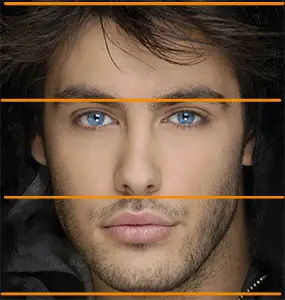
However, a second definition, and probably what most people think of as the midface, is the region from the brow line to the upper lip.
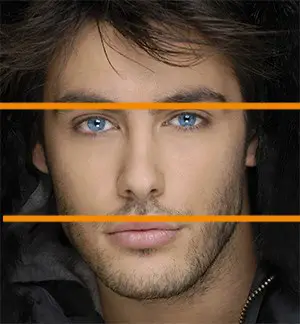
For our purposes, we’ll go with the first definition of the midface as the middle third of the face.
Facial Thirds
Leonardo DaVinci described the anatomy of the human face as divided into rarely equal thirds.
- Upper third – trichion (middle point of the hairline) to the glabella (the smooth area between the eyebrows).
- Middle third – glabella to the subnasale (midline point where the upper lip and nasal septum meets).
- Lower third – subnasale to the menton (Most inferior point of the chin).
The proportions of the facial thirds vary depending on ethnicity. For white men and women, the upper and lower thirds tend to be longer than the middle third. This facial trait has also been observed in black males. In Chinese women, the middle and lower thirds are commonly longer than the upper third, giving them less prominent foreheads. This is the opposite for black women, who often have a relatively long upper third.
Here is a summary of the variations of the horizontal thirds depending on ethnicity:
|
Ethnicity |
Divergences from Equal Horizontal Thirds |
| White men and women, black men | Decreased distance from the glabella to the subnasale |
| Black Women | Increased distance from the trichion to the glabella |
| Chinese Women | Decreased distance from the trichion to the glabella |
It is quite clear that a short midface is more desirable than a long midface. But it’s not the end of the world if you happen to have a long midface. You can downplay your long midface and improve your appearance by mewing, surgery, or using a facial appliance like a protraction facemask.
Ideal Midface Dimensions
You can tell if the midface is too long or too short by looking at the facial width to height ratio, which should be around 1.5 to 2. Or you can look at the midface ratio, which should be around 1. You can also go by facial thirds, where your midface should be a third of your face.
If you have a high facial width to height ratio (FWHR), you have a short midface. If you have a low FWHR, then you have a long midface.
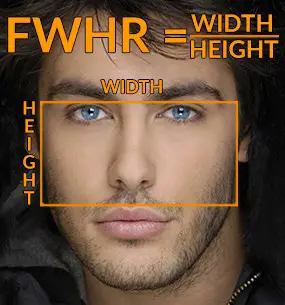
The midface ratio measures the distance between your pupils and the height of your midface. A perfect midface should have a midface ratio of 1 to 1. The higher your midface ratio is, the shorter your midface is. The lower your midface ratio is, the longer your midface is.

Alternatively, you can evaluate the midface in terms of facial thirds. Unlike the previous two measurements, this ignores the length of the philtrum.

But sometimes these ratios can be thrown off by other factors. To truly evaluate the midface, you have to eyeball the face and try to look at the relative size of the midface.
Female Midface
Neoteny is the retention of juvenile features, or youth essentially. Men prize neotenous features in women because a youthful woman is a higher guarantee of healthy offspring. A compact midface is a neotenous feature that makes women look younger and more feminine. Other neotenous features that add to a women’s attractiveness along with a short midface are:
- Large eyes
- Chubby cheeks
- Soft and smooth skin
- A cute button nose
- Rounded chin
A long midface is generally not ideal for women. However, it’s still workable and can help project an air of exclusivity and maturity, which is commonly sought after in modeling.
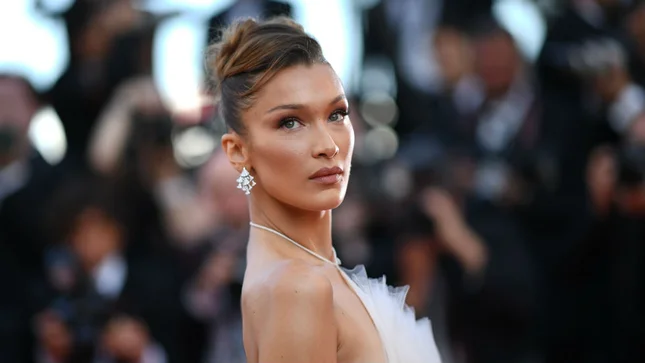
In addition, a longer midface allows more room for cheek hollows.
Male Midface
Men can get away with a longer midface than women. Because neotenous features are not attractive on men, having a longer midface is usually not a big deal. This is why David Schwimmer can get away with his insanely long midface.
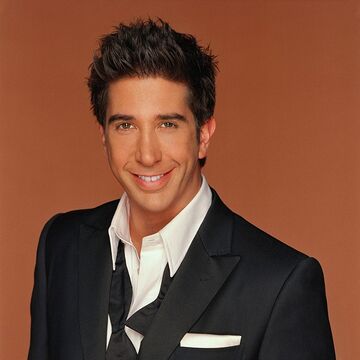
However, this isn’t ideal. A midface ratio of 1 to 1 is still best for men, and a shorter midface on men is still more attractive than a longer midface.
A Recessed Maxilla Causing a Longer Face
The maxilla is the central bone of the midface. It serves as the base of the orbits, the palate, and the nasal cavity. It plays a vital role in facial aesthetics because it determines the layout of the other facial features. A balanced and more symmetrical face results from a well-developed maxilla.
When you have a recessed maxilla, your maxilla is set back more posteriorly in the face, as well as sunken. A recessed maxilla means a recessed jawline. This is because the mandible is locked to the maxilla. Since the maxilla supports the eyes, having a recessed maxilla may also result in eye bags and dark circles. Other features include:
- A crooked nose
- Sunken cheekbones
- Narrow face
- Tired eyes
- Crowded teeth
- A setback chin or double chin
- Excessive gum display
A person with a recessed maxilla is usually not as attractive as one with an adequately developed maxilla. A recessed maxilla not only decreases the aesthetics of the face, but it also causes a handful of functional problems.
The size of the airway is reduced with a recessed maxilla. The reduction in the size of the airway can cause snoring and sleep apnea. Young children tend to have a good facial structure. But as they mature, they can develop allergies or bad habits that may cause their maxilla to recede. Some of these bad habits include breathing through the mouth and incorrect tongue posture. All of these bad habits affect the airway and, ultimately, the maxilla.

A recessed maxilla can also cause temporomandibular joint (TMJ) syndrome. This common disorder affects up to 33% of all people in their lifetime. It causes pain at the joint where the temporal bone and the mandible meet. In severe cases, it may cause chronic pain that is treatable with surgery. However, if the joint has been too severely damaged, repair may not be possible.
For more on our take on TMJ and how to fix it, check out our article.
Fixing A Long Midface
As mentioned, having a long midface is not necessarily a death sentence. Both men and women can get away with it. However, if you feel like you absolutely can’t, there are still things you can do to fix it.
Mewing, a LeFort surgery, and MSE with a facemask can help fix a long midface.
Mewing Can Help Fix A Recessed Maxilla
A recessed maxilla is mainly caused by poor tongue posture. However, this can be solved with mewing. Mewing improves the structure of the facial bones and results in a more attractive face.
Here’s an animation of what mewing can do over time:
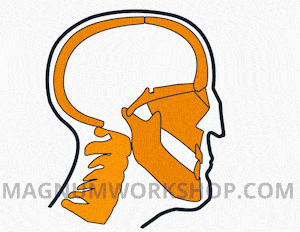
However, keep in mind this is a long term strategy. Going from a recessed to a perfect maxilla can take years, if not decades.
LeFort I Osteotomy
The LeFort I Osteotomy surgery is the fastest way of correcting a recessed maxilla. This surgery will target the deformities in the midface and correct them. The surgeon will move the maxilla forward, elongate, augment, or shorten it to get the desired results. The surgeon will often suggest LeFort I osteotomy together with mandibular surgery.
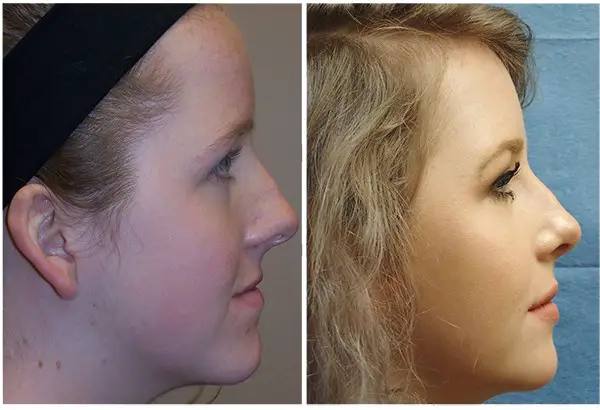
Before the surgery, careful surgical planning and orthodontics will be in place to ensure the best outcome. This surgery is popular and in-demand because of the positive long-term results and fewest amount of complications.
MSE and Protraction Facemasks
MSE is short for Maxillary Skeletal Expander, another type of MARPE designed by Dr. Won Moon. MARPE stands for micro-implant-assisted rapid palatal expander. It splits the maxilla in half at the midpalatal suture.
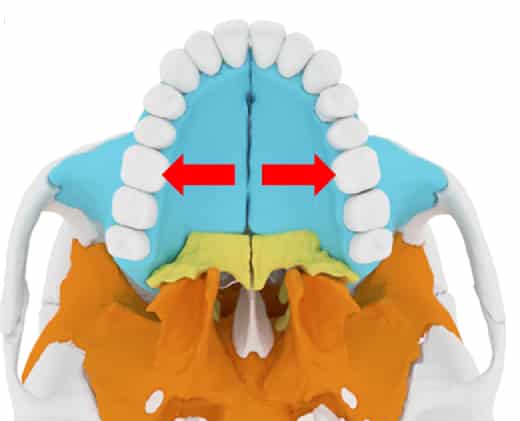
The unique features of MSE help get different treatment outcomes compared to other MARPEs. The main difference is that MSE splits the maxilla from the back instead of the front. The MSE can expand the midface, increasing the facial width to height ratio.
If you combine MSE with the use of a facemask (protraction), the vertical side effects will be negligible. The use of facemask and MSE will also widen the palate.

A protraction facemask is an appliance commonly used to treat Class III malocclusions where the maxilla is deficient. The facemask will cause downward and forward traction on the upper jaw.
A metal bar serves to maintain support for the chin and forehead. The supports include a forehead rest and a chin cup. These can be individually adjusted to match the height of the patient’s face. Wear them in the evening for about 8 to 12 hours. With consistency and diligence, you will see results in a matter of time. Be warned, though, that the forces induced by the elastics on the facemasks are strong. It is vital that the skin on the forehead and chin gets a chance to rest and breathe during the daytime.
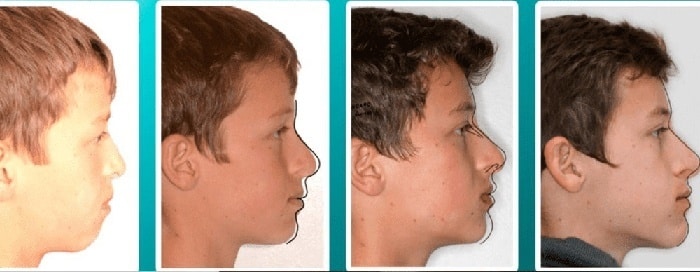
The above is an example of the results you can expect with MSE when starting treatment at an early age. However, adults can have similar results, albeit slower.

